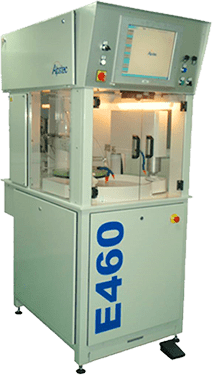Recently ALPSITEC, conducted a training session on wafer polishing, that PhotonExport assisted and supported, for the Chemical-Mechanical Polishing equipment that we recently assisted in installing at UPVfab’s facilities.
At the heart of our mission lies a commitment of enabling sustainable and cutting-edge, state-of-the-art Research and Development innovation in thin films and nanotechnology. Our mission drives us to support and assist industry experts in their pursuit of excellence.
The realm of semiconductor manufacturing demands precision, accuracy, and continuous improvement. In a pursuit to further optimize the process, our Materials Engineer had the unique privilege of assisting and supporting ALPSITEC for an in-depth training session. The training session was aimed at enriching the knowledge of the brilliant researchers from UPVfab’s Micro-fabrication pilot line, focusing on the operation of the E460 Chemical-Mechanical Polishing machine.
Wafer Polishing Training Session
In this comprehensive training session, the team delved deep into the high-tech world of semiconductor wafer polishing, a pivotal element in the manufacturing process that plays a crucial role in producing top-quality semiconductor wafers. Throughout various manufacturing processes, wafer surfaces can become damaged. While this might appear relatively smooth, it can potentially jeopardize the functionality of the wafer in certain applications. To rectify this issue, the polishing process is employed, with Chemical Mechanical Polishing (CMP) emerging as the most commonly used technique.
Here’s an overview of the training’s key highlights:
- Fine-Tuning Slurry and Water Flow Levels
One of the core aspects of wafer polishing involves adjusting the levels of slurry and water flow. This precise calibration is essential to ensure optimal wafer polishing and maintain consistency in the process. - Replacing the Polishing Pad
The training emphasized the importance of regularly replacing the polishing pad with a new one. This simple yet crucial step ensures that each polishing session starts with a fresh surface, guaranteeing consistent results. - Conditioning the Polishing Pad
Conditioning the polishing pad is a vital preparatory step in wafer polishing. It involves using a diamond head conditioning tool to soften the pad’s surface, making it ready for its first use. This process contributes significantly to the overall efficiency of the wafer polishing operation. - Creating a Recipe for Wafer Conditioning
Developing a recipe for wafer conditioning is essential for maintaining a clean pad surface. This recipe is used both before and after the polishing process, effectively removing any particles that may be left on or embedded into the pad. It’s a meticulous process that ensures consistency and quality in wafer polishing. - Formulating a Recipe for Wafer Polishing
This part of the training focused on creating a recipe for wafer polishing. It involves adjusting the pressure applied to the wafer during the process to achieve uniformity in polishing. To accomplish this, nitrogen is employed to create a pressurized gas flow behind the wafer, ensuring uniform contact with the surface. Nitrogen is used for its inert properties, which guarantees that the wafer’s characteristics remain unaltered throughout the process.

Additional wafer polishing Features and Options
In addition to these core elements, the training session also highlighted some noteworthy features and options of the E460 Chemical-Mechanical Polishing machine:
Variable Wafer Sizes: To process different wafer sizes the training also touched upon the adjustments needed to set up the right carrier and polishing head, depending on the wafer’s size.
Temperature Control: In order to maintain a controlled polishing plate temperature the training looked into the settings and adjusting a chiller connection.
With the knowledge and skills gained from this training session, the brilliant researchers from UPVfab’s Micro-fabrication pilot line are well-prepared to harness the full potential of the E460 Chemical-Mechanical Polishing machine. We eagerly await the remarkable accomplishments that lie ahead for them and the industry as a whole.
Don’t forget to visit our Equipment Page to learn more about semiconductor and thin film equipment offerings.

